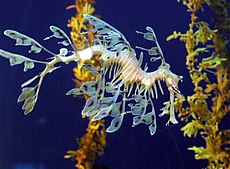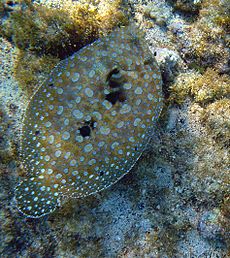Fish


Fish (plural: fish or fishes) are an aquatic group of vertebrates which live in water and respire (get oxygen) with gills. They do not have limbs, like arms or legs, and they do have digits (fingers & toes). This is a definition which does not quite work: some amphibia also live in water and have external gills, but they are not fish.
Fish used to be a class of vertebrates. Now the term covers five classes of aquatic vertebrates:
There are more fish than tetrapods (land vertebrates): there are over 33,000 described species of fish.[4] Fish are usually covered with scales. They have two sets of paired fins and several unpaired fins. Most fish are cold-blooded (poikilotherm). A fish takes in the oxygen from the water using gills. There are many different kinds of fish. They live in fresh water in lakes and rivers, and in salt water in the ocean. Some fish are less than one centimeter long. The largest fish is the whale shark, which can be almost 15 meters long and weigh 15 tons. Most fish live in the water. A group of fish called the lungfish have developed lungs because they live in rivers and pools which dry up in certain parts of the year. They burrow into mud and aestivate until the water returns.
'Fish' is a paraphyletic term in cladistics because it lacks a monophyletic group of descendants. It does not include the land vertebrates or tetrapods, which descended from fish.
Types of fish[edit | edit source]
"Fish" is not a formal taxonomic grouping in systematic biology. Amphibians, reptiles, birds and mammals all descended from lobe-finned fish (and not from fish as a whole). But the use of the term "fish" is so convenient that we go on using it.
Fish are the oldest vertebrate group. The term includes a huge range of types, from the Middle Ordovician, about 490 million years ago, to the present day. These are the main groups:[5][6]
- Agnatha: the jawless fish. Cambrian to present day.[7]
- Pteraspids: the head-shields
- Anaspids: gills opened as holes. Silurian to end-Devonian.
- Cephalaspids: early jawless fish
- Lampreys: living ectoparasites
- Osteostraci: bony-armoured jawless fish.
- Gnathostomata: the jawed fish. Includes all types commonly called fish, except the lamprey.
- Placoderms: heavily armoured fish
- Chondrichthyes: cartilaginous fish: sharks, rays and skates.
- Acanthodii: extinct spiny sharks
- Osteichthyes: bony fish.
- Actinopterygii: the ray-finned fish.
- Chondrostei: sturgeons and some other early types.
- Neopterygii: first seen in the later Permian, lighter and faster-moving than previous groups.
- Sarcopterygii: the lobe-finned fish
- Dipnoi: the lungfish; eight genera survive.
- Coelacanths: two species survive. They were probably a sister-group to the tetrapods.
- Actinopterygii: the ray-finned fish.
Certain animals that have the word fish in their name are not really fish: Crayfish are crustaceans, and jellyfish are Cnidarians. Some animals look like fish, but are not. Whales and dolphins are mammals, for example.
Anatomy[edit | edit source]
Bony and cartilagenous fish[edit | edit source]
Most kinds of fish have bones. Some kinds of fish, such as sharks and rays, do not have real bones. Their skeletons are made of cartilage, and so they are known as cartilaginous fish.
Fish scales[edit | edit source]
All fish are covered with overlapping scales, and each major group of fish has its own special type of scale. Teleosts ('modern' fish) have what are called leptoid scales. These grow in concentric circles and overlap in a head to tail direction like roof tiles. Sharks and other chondrichthyes have placoid scales made of denticles, like small versions of their teeth. These also overlap in a head to tail direction, producing a tough outer layer. Shark skin is available for purchase as shagreen, a leather which as original is smooth in one direction, and rough in the other direction. It may be polished for use, but is always rough in texture and resistant to slipping.
The scales are usually covered with a layer of slime which improves passage through the water, and makes the fish more slippery to a predator.
Freshwater fish[edit | edit source]
41% of all fish live in freshwater. There are also some important fish which breed in rivers, and spend the rest of their life in the seas. Examples are salmon, trout, the sea lamprey,[8] and three-spined stickleback. Some other fish are born in salt water, but live most of their adult lives in fresh water: for example the eels. Species like these change their physiology to cope with the amount of salt in the water.
Swimming[edit | edit source]
Fish swim by exerting force against the surrounding water. There are exceptions, but this is usually done by the fish contracting muscles on either side of its body in order to generate waves of flexion that travel the length of the body from nose to tail, generally getting larger as they go along. Most fishes generate thrust using lateral movements of their body & tail fin (caudal fin). However, there are also species which move mainly using their median and paired fins. The latter group profits from the gained manoeuvrability that is needed when living in coral reefs for example. But they can not swim as fast as fish using their bodies & caudal fins.[9]
Muscle[edit | edit source]
Fish can swim slowly for many hours using red muscle fibres. They also make short, fast bursts using white muscle. The two types of muscle have a fundamentally different physiology. The red fibres are usually alongside a much greater number of white fibres.
The white fibres get their energy by converting the carbohydrate glycogen to lactate (lactic acid). This is anaerobic metabolism, that is, it does not need oxygen. They are used for fast, short bursts. Once the lactic acid builds up in the muscles, they stop working, and it takes time for the lactate to be removed, and the glycogen replaced.[10] Using their white fibres, fish can reach speeds of 10 lengths per second for short bursts.[10]
Swimming for long periods needs oxygen for the red fibres. The oxygen supply has to be constant because these fibres only operate aerobically. They are red because they have a rich blood supply, and they contain myoglobin. Myoglobin transports the oxygen to the oxidising systems. Red muscle gets its energy by oxidising fat, which weight for weight has twice as much energy as carbohydrate or protein.[10] Using their red fibres, fish can keep up a speed of 3–5 lengths per second for long periods.[10]
Swimming in groups[edit | edit source]
Many fish swim in groups. Schools of fish can swim together for long distances, and may be chased by predators which also swim in schools. Casual groups are called 'shoals'.
Body shape[edit | edit source]
The shape of the body of a fish is important to its swimming. This is because streamlined body shapes makes the water drag less. Here are some common fish shapes:-
The picture on the right shows a shark. This shark's shape is called fusiform, and it is an ovoid shape where both ends of the fish are pointy. This is the best shape for going through water quickly.[11][12] Fishes with fusiform shapes can chase prey and escape predators quickly. Many live in the open ocean and swim constantly, like marlins, swordfish, and tuna. Ichthyosaurs, porpoises, dolphins, killer whales all have similar shapes. This is an example of convergent evolution.
Eel-like[edit | edit source]
The long, ribbon-like shape of an eel's body shows another shape. This enables them to hide in cracks, springing out quickly to capture prey, then returning quickly to their hiding spot.
Flatfish[edit | edit source]
Flatfish live on the bottom of the ocean or lake. Most use camouflage: they change colours to match the ocean floor. During their early lives, their eyes move to the upper side of their flat body.
Reef fish also have flat bodies, and their body is often highly coloured. Flat bodies can slip in and out among the corals, sponges, and rocks, avoiding predators. Angelfish, surgeonfish, and butterflyfish are examples.
Fish as food[edit | edit source]
Some people eat many different kinds of fish. These include carp, cod, herring, perch, sardines, sturgeon, tilapia, trout, tuna, and many others. A person who buys and sells fish for eating is called a fishmonger.
The word to fish is also used for the activity of catching fishes. People catch fish with small nets from the side of the water or from small boats, or with big nets from big boats. People can also catch fish with fishing poles and fishhooks with bait. This is often called angling. Anglers also different types of fishing lures.
Because people are catching too many fish for food or other uses, there are less and less fish in the sea. This is a problem known as Overfishing.
Fish as pets[edit | edit source]
Selective breeding of carp made them into the domesticated koi in Japan, and goldfish in China. This breeding began over 2,000 years ago. The Chinese brought their goldfish indoors during the Song Dynasty. They kept them in large ceramic vessels. That we now do in glass fish tanks.
References[edit | edit source]
- ↑ Leafy and Weedy Sea Dragon National Geographic Profile. Retrieved 20 July 2009.
- ↑ Template:IUCN2006
- ↑ Long J.A. 1995. The rise of fishes: 500 million years of evolution. Johns Hopkins, Baltimore.
- ↑ FishBase
- ↑ Moyle P.B. and Cech J.J. 2003. Fishes: an introduction to Ichthyology. 5th ed, Cummings. ISBN 978-0-13-100847-2
- ↑ Maisey J.G. 1996. Discovering fossil fishes. Holt N.Y.
- ↑ Janvier, Philippe 2010. MicroRNAs revive old views about jawless vertebrate divergence and evolution. Proceedings of the National Academy of Sciences (USA) 107:19137-19138. [1] Archived 2015-09-24 at the Wayback Machine
- ↑ Silva S. et al 2014. The haematophagous feeding stage of anadromous populations of sea lamprey Petromyzon marinus: low host selectivity and wide range of habitats. Hydrobiologia, 734(1), 187-199.
- ↑ Breder C.M. 2003. The locomotion of fishes. Zoologica, 4, 159-256, (1926); Journal of Experimental Biology 206, 2749-2758 (2003)
- ↑ 10.0 10.1 10.2 10.3 Alexander, R. McNeill. 1974. Functional design in fishes. London: Hutchinson, p31. ISBN 0-09-104751-X
- ↑ Nielsen, Knut Schmidt 1984. Scaling: why is animal size so important? Cambridge. Chapter 15
- ↑ Baily, Jill 1997. How fish swim. Benchmark, N.Y.
See also[edit | edit source]
- Fish -Citizendium







